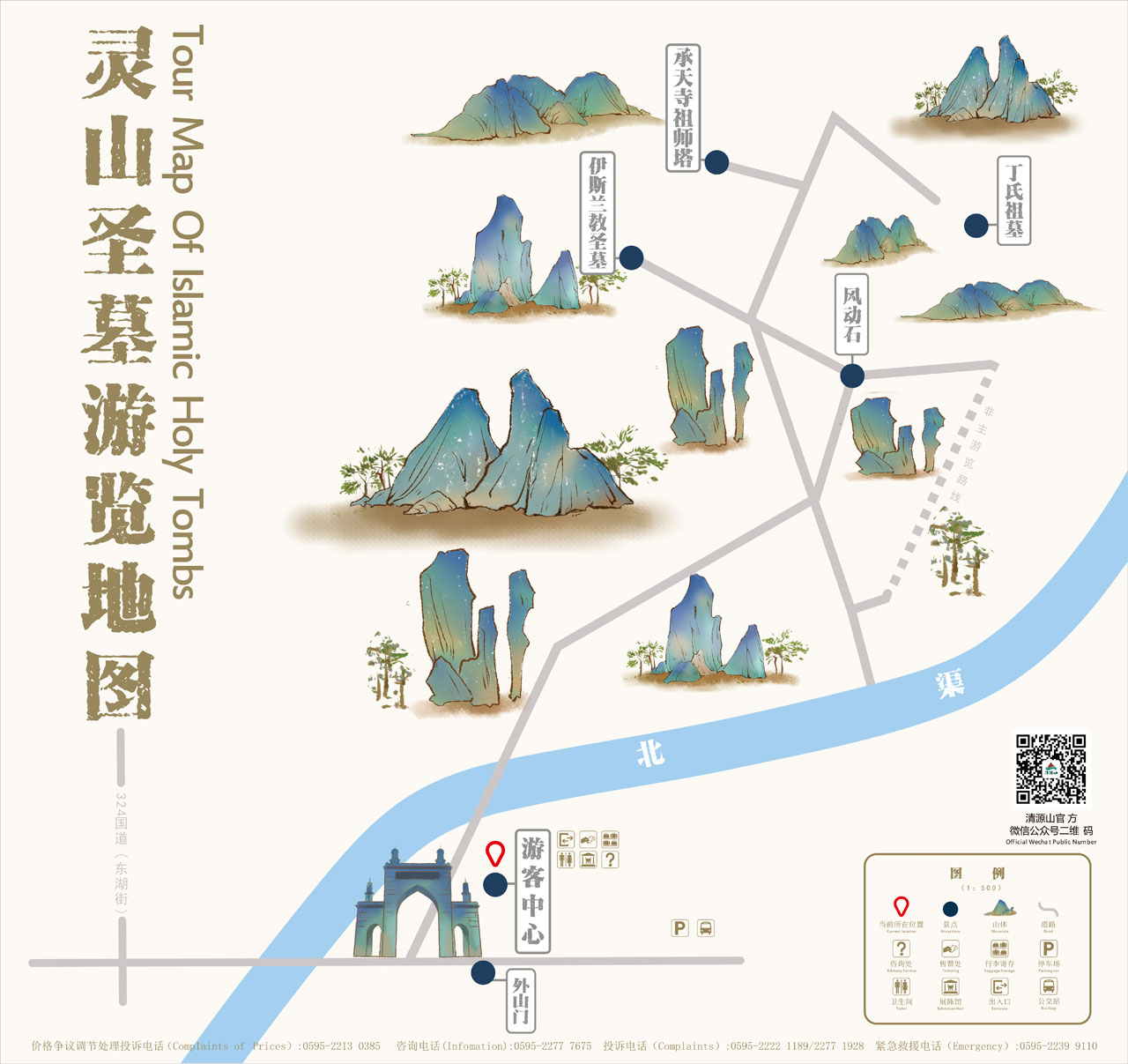
The oldest and most intact holy Islamic relics in China is located at Lingshan scenic spot in Qingyuan Mountain Attractions. In the initial stage of the foundation of Islam, missionaries responded to Muhammad's call, and came to China along Silk Road of the Sea. Quanzhou became one of the earliest regions in China where Islam was introduced. During Wude Reign of Tang Dynasty(the year of 618—626), four sages among disciples of Muhammad did missionary work in China, the first sage in Guangzhou, the second sage in Yangzhou, the third sage Sha Ye Chu and the fourth sage Wo Gao Shi in Quanzhou, and the latter two were buried in Lingshan Hill after death.

Geographic location:
Holy Tomb, Lingshan Road, Fengshan Community, Donghu Street, Fengze District, Quanzhou City, Fujian Province, China.
Humanistic history
In the initial stage of the foundation of Islam, missionaries responded to Muhammad's call of ‘You go to seek knowledge, even if as far as in China’, came with Arabian businessmen along Silk Road of the Sea, and Quanzhou became one of the earliest regions in China where Islam was introduced. As recorded in Fujian Chronicles by He Qiaoyuan in Ming Dynasty, during Wude Reign of Tang Dynasty(the year of 618—626 AD), Muhammad sent four sagacious disciples on mission to China, the first sage did missionary work in Guangzhou, the second in Yangzhou, the third sage Sha Ye Chu and the fourth sage Wo Gao Shi in Quanzhou, and the latter two were buried in Lingshan after death. After their burial, the mountain glowed in the dark, people were amazed at its sacred spirit, naming it holy tomb and mountain Lingshan Hill. Legend has it that holy spirit appeared after their burial, which was called ‘holy’ or ‘spirit’ in southern Fujian colloquialism. Thus, this place was named ‘Lingshan’, and the tomb ‘Holy Tomb’, hinting the double meanings of holy spirit and respect.

Influence
There are hundreds of ancient Muslim tombs in Quanzhou since Yuan Dynasty near the Holy Tomb. Many Hui and Muslim people in Quanzhou always come to ‘visit the tomb’ together every Lesser Bairam and Corban Festival, first pay a formal visit of the tombs of the two sages, chant the Koran, then clean and offer sacrifices at their ancestral tombs respectively.
Qingyuan Mountain is one of the integration entity of multiple religions and cultures, and Lingshan Hill is the oldest cultural relic imprint of Islam in China. It was listed as historical and cultural site under government protection of Fujian Province in 1963, and into the third batch of National Priority Cultural Relic Protection Sites in 1988. This tomb of Islamic saints has been protected by Quanzhou people and Muslims all the time from generation to generation for thousands of years. It’s extremely precious Islamic historical relics of China, and important historic materials to study overseas traffic history and Islamic dissemination history of Quanzhou.
Attractions--- Lingshan Holy Tomb
Lingshan Holy Tomb is located at the southern foot of Lingshan Hill. There are luxuriant trees and green grasses like a green carpet on the mountain, and there is an exotic ancient tomb in style in half way up the hill. Two graves stand side by side beneath a stone pavilion. The grave blanket carved in granite is divided into three layers, ladder-shaped, with a total height of 60cm; the bottom layer is rectangular, 2.15m long and 1.10M wide, with lotus petal pattern carved in relief on its four sides; the middle layer is simple; the top layer is in the shape of arch, 1.55 m long. The vault faces south, and a u-shaped ambulatory is built along the hill in the east, west and north. Under the grave blanket is a stone slab covering the grave pit. The ground of the vault, ambulatory, chamber court and stone platform are all paved with carved granite, which look very clean, elegant and simple.

Inside the ambulatory there stand seven inscriptions through the ages. In the middle is the grave monument with Arabic writing rebuilt in Ramadan, the year of 722 in Islamic calendar, on the left is Stele of Zheng He's Pilgrimage. In addition, there are renovated holy grave monument by sages in past dynasties. In the open ground at one side of the Holy Tomb are Muslim cemeteries from all over the world during Song and Yuan Dynasties as well as Islamic stone grave blankets in Ming and Qing Dynasties, on which the pattern of ‘cloud and moon’ commonly used in Islam and fragments of the Koran are engraved.
Attractions--- Wind-swaying Stone

There is a huge natural stone before the tomb, interesting and ingenious. It seems to waggle with a wind, and sway with a push, so it’s named ‘Wind-swaying Stone’, which is one of the three wind-swaying stones in Fujian Province. ‘Jade Ball’ inscribed by Quanzhou Magistrate Zhou Daoguang of the Ming Dynasty on the stone is followed by the inscription of ‘Natural Wonder’ by later people, hence it’s called ‘Jade Ball Wind Swaying’. It’s considered by Muslims at home and abroad as the plan of Allah, attracting thousands of travelers to visit out of admiration for its magic.
All rights reserved. Fujian Qingyuan Mountain Tourism Investment Co., Ltd
Address: East side of Qingyuan Mountain Tourist Center, Fengze District, Quanzhou City
TEL:0595-22777675 FAX:0595-22768138 闽ICP备18014938号-2